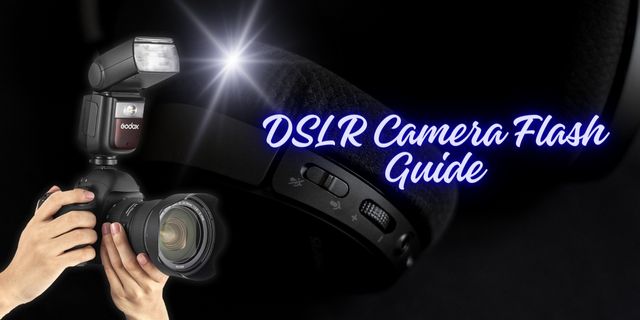DSLR Camera Flash Guide: Built-in vs. External
A DSLR camera flash guide explains the difference between built-in and external flash. Built-in flash is part of the camera body and is limited in power and direction. External flash is a separate unit that can be more powerful and versatile, with the ability to bounce light off ceilings and walls. It also allows for off-camera lighting, which can create more dynamic and creative images. However, external flash units can be expensive and require additional accessories such as triggers and stands.
Built-in vs. External
When it comes to photography, lighting is one of the most important factors to consider. Without proper lighting, your photos can come out dull and uninteresting. This is why having a flash is essential for any photographer, especially those using DSLR cameras. But with so many options available, it can be difficult to decide between a built-in flash or an external flash. In this guide, we will explore the differences between the two and help you determine which one is right for you.
Built-in Flash
A built-in flash is exactly what it sounds like - a flash that is built into the camera itself. Most DSLR cameras come with a built-in flash, and it can be a convenient option for quick snapshots or low-light situations. Built-in flashes are typically small and compact, making them easy to carry around and use on-the-go.
However, there are some downsides to using a built-in flash. First and foremost, the light that comes from a built-in flash is often harsh and unflattering. This is because the flash is located very close to the lens, which can cause red-eye and other unwanted effects. Additionally, the range of a built-in flash is limited, meaning it may not be powerful enough to light up larger spaces or subjects that are further away. Finally, using a built-in flash can drain your camera's battery more quickly than an external flash.
External Flash
An external flash, also known as a "speedlight," is a flash that is separate from the camera body. These flashes are typically larger and more powerful than built-in flashes, and they can be mounted onto the camera's hot shoe or used off-camera with a wireless trigger. External flashes offer a range of benefits over built-in flashes, including:
- More powerful, versatile lighting options
- Greater range
- Ability to bounce light off of walls and ceilings for more natural-looking results
- Reduction of red-eye and other unwanted effects
External flashes can be more expensive than built-in flashes, but they are worth the investment for photographers who want more control over their lighting. Additionally, because external flashes are separate from the camera body, they can be used with multiple cameras, making them a versatile option for photographers who shoot with different camera models.
Which One Should You Choose?
Ultimately, the decision between a built-in flash and an external flash depends on your needs as a photographer. If you are just starting out and want a simple, convenient option for low-light situations, a built-in flash might be a good choice. However, if you are serious about photography and want more control over your lighting, an external flash is the way to go.
For photographers in India, DSLR cameras are a popular choice due to their versatility and image quality. If you are an Indian photographer looking to upgrade your equipment, consider investing in an external flash to take your photos to the next level. To learn more about why DSLR cameras are better than mirrorless cameras, check out our guide.
| Feature | Built-in Flash | External Flash |
| Cost | Less expensive | More expensive |
| Size and portability | Small and compact | Larger and less portable |
| Lighting options | Limited | More powerful and versatile |
| Range | Limited | Greater |
| Control over lighting | Less control | More control |
Sharing is caring!
Facebook Twitter Email
Recommended articles for Camera
Camera types and buying guide
-
How to Choose the Right Camera for Your Needs
-
DSLR Camera Shutter: Understanding Shutter Speed
-
Understanding DSLR Viewfinders: Optical vs. Electronic
-
Understanding Camera Sensor Sizes: APS-C vs. Full Frame
-
DSLR Camera vs. Smartphone Photography: Pros and Cons
-
Introduction to DSLR Camera Modes: When to Use Each
-
DSLR Camera ISO: Understanding Sensitivity and Noise
-
DSLR Camera Memory Cards: Types and Recommendations
-
DSLR Camera Flash Guide: Built-in vs. External
-
Exploring DSLR Camera Viewfinders: Optical vs. Electronic
-
DSLR vs. Point-and-Shoot: Choosing the Right Camera for You
-
DSLR Camera Flash Options: Built-in and External and Off-Camera
-
DSLR Camera Lenses: Prime vs Zoom
-
DSLR Camera Lens Mounts: Compatibility and Interchangeability
-
DSLR Camera Lens Filters: UV and Polarizer and ND Filters
-
DSLR Camera Lens Aperture: Understanding F-Numbers
-
DSLR Camera Lens Focal Length: Zoom Range and Perspective
-
DSLR Camera Histogram: Understanding and Using It
-
DSLR Camera Lens Adapters: Expanding Lens Compatibility
-
DSLR Camera Lens Extenders: Increasing Focal Length
-
Choosing the Right Camera Lens for Landscape Photography
-
A Beginner's Guide to DSLR Cameras: Getting Started
-
Why DSLR is better than mobile camera
-
Why DSLR is better than mirrorless?
-
Is mirrorless better than DSLR camera?
-
What is the advantage of mirrorless vs DSLR?
-
What is a mirrorless camera?
-
What is full frame mirrorless camera?
-
Understanding Camera Lens Types: A Comprehensive Overview
-
DSLR Camera Lens Guide: Types and Their Uses
-
DSLR Camera Sensors: CMOS vs. CCD
-
Understanding Aperture: The Key to Controlling Depth of Field
-
Choosing the Ideal Camera Bag: Protecting Your Gear in Style
-
Mastering Shutter Speed: Freezing or Blurring Motion with Precision
-
Camera Gear Essentials: Must-Have Accessories for Every Photographer
-
DSLR vs. Mirrorless: Choosing the Right Camera System
-
DSLR Camera Settings Demystified: Understanding the Basics
-
DSLR Camera Lenses: A Comprehensive Guide
-
Understanding DSLR Metering Modes: Getting Proper Exposures


